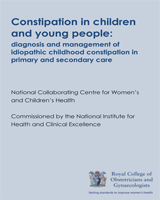| Van Den Berg et al. Epidemiology of childhood constipation: A systematic review. 2006. American Journal of Gastroenterology 101[10], 2401-2409United States. | No experimental data |
| Waseem et al. Megacolon: Constipation or volvulus? 2006. Pediatric Emergency Care 22[5], 346-348United States. | 1 single case control study |
| Skowronska-Piekarska et al. The importance of the history taking procedure in the assessment of clinical meaning of constipation symptoms. 2007. Gastroenterologia Polska 14[4], 265-269Poland. | Mainly adult population (Mean 47.7 years for women) and all men over 45 years. |
| Chan et al. Influence of positive family history on clinical characteristics of functional constipation. 2007. Clinical Gastroenterology and Hepatology 5[2], 197-200 | Adult population |
| Stordal et al. Organic abnormalities in recurrent abdominal pain in children. 2001. Acta Paediatrica 90[6], 638-642 | Prospective case series, no comparison group. No details of the history taking elements reported |
| Voskuijl et al. Use of Rome II criteria in childhood defecation disorders: applicability in clinical and research practice. 2004. Journal of Pediatrics 145[2], 213-217 | Prospective case series, no comparison group. Comparison between 2 sets of diagnostic criteria previously defined by expert consensus applied to the same group of children |
| Loening-Baucke. Functional fecal retention with encopresis in childhood. 2004. Journal of Pediatric Gastroenterology and Nutrition 38[1], 79-84 | Retrospective case series, no comparison group. Comparison between 2 sets of diagnostic criteria previously defined by expert consensus applied to the same group of children |
| Klijn et al. The diameter of the rectum on ultrasonography as a diagnostic tool for constipation in children with dysfunctional voiding. 2004. Journal of Urology 172[5 Pt 1], 1986-1988 | Case control study concerned with the diagnostic value of the abdominal ultrasound. Clinical data poorly reported, no analysis conducted comparing the 2 study groups |
| Joensson et al. Transabdominal ultrasound of rectum as a diagnostic tool in childhood constipation. 2008. Journal of Urology 179[5], 1997-2002 | Case control study concerned with the diagnostic value of the abdominal ultrasound. Detailed analysis of comparing clinical data in constipated children with healthy controls not performed. Constipation diagnosed by using a set of diagnostic criteria previously defined by expert consensus |
| Barr et al. Chronic and occult stool retention: a clinical tool for its evaluation in school-aged children. 1979. Clinical Pediatrics 18[11], 674-679 | Case control study concerned with the diagnostic value of the plain abdominal radiography. Detailed analysis of comparing clinical data in constipated children with non constipated controls not performed. Constipation diagnosed by using a set of diagnostic criteria previously defined by expert consensus |
| Giramonti et al. The association of constipation with childhood urinary tract infections. 2005. Journal of Pediatric Urology 1[4], 273-278United Kingdom. | Case control study concerned with the relationship between a history of constipation, faecal loading on X-rays and a history of UTIs in an office practice Detailed analysis of comparing clinical data in constipated children with non constipated controls not performed. Unclear what criteria were used to diagnose constipation |
| Beckmann et al. Accuracy of clinical variables in the identification of radiographically proven constipation in children. 2001. Wisconsin Medical Journal 100[1], 33-36United States. | Elements of the history/physical examination analysed in the study were very limited (1 for history and 2 for physical examination apart for the digital rectal examination). The 2 elements of the physical examination contributed to exclude a surgical cause of abdominal pain, but not to establish a positive diagnosis of idiopathic constipation. This study might be relevant for the review on the diagnostic value of the digital rectal examination |
| Rockney et al. The plain abdominal roentgenogram in the management of encopresis. 1995. Archives of Pediatrics and Adolescent Medicine 149[6], 623-627 | There is no comparison between constipated and non constipated children, but between 2 groups of children both of whom presented with soiling. This study might be relevant for the review on the diagnostic value of the digital rectal examination as a means of assessing faecal retention |
